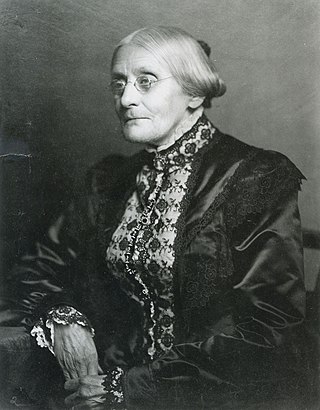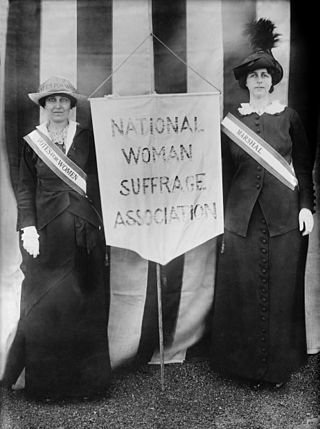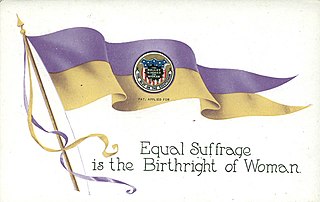
Catharine A. Fish Stebbins (August 17, 1823 - 1904) was an American abolitionist and suffragist. She lectured against slavery and fought for her right to vote in New York and Michigan.

Catharine A. Fish Stebbins (August 17, 1823 - 1904) was an American abolitionist and suffragist. She lectured against slavery and fought for her right to vote in New York and Michigan.
Stebbins was born Catherine A. Fish in Farmington, New York to a family of radical Quakers on August 17, 1823. [1] [2] [3] Her mother was Sarah D. Bills Fish. [1] The family moved to Rochester, New York when Stebbins was five and her parents started an abolitionist group in the city. [1] Stebbins was involved as young as age twelve, collecting names for anti-slavery petitions. [2] [3] She assisted her family in operating one of the first waystations of the Underground Railroad in the city of Rochester, New York. [3]
Stebbins became a teacher in Rochester. [1] In 1842, she joined the Western New York Anti-Slavery Society (WNYASS). [3] She married Giles Badger Stebbins in August 1846 in Sodus Bay. [2] Her husband was an abolitionist as well, and together, they lectured and were involved in peaceful demonstrations for women's suffrage and the end of slavery. [4] In 1848, Stebbins was at the first Woman's Rights Convention, where she was an active participant and contributed a resolution to the convention. [2] In the early 1850s, she and her husband moved to Michigan. [2]
When the National Woman Suffrage Association (NWSA) was founded in 1861, she joined. [1] She and her husband also spoke that same year at the Michigan State Anti-Slavery Society. [4] She was also anti-war and was opposed to her brother joining the Union during the Civil War. [5] She helped refugees from the war. [2]
In 1871, Stebbins attempted to register to vote in Michigan, but was denied. [2] She then went with Nannette B. Gardner, who was asserting her right to vote as a widow and a taxpayer. [2] Gardner was given the right to vote, but Stebbins was never able to register. [2] In 1880, Stebbins was in charge of the Detroit NWSA convention. [6] Stebbins was also on the committee to work on The Woman's Bible . [7]
Stebbins died in 1904. [2]

Susan B. Anthony was an American social reformer and women's rights activist who played a pivotal role in the women's suffrage movement. Born into a Quaker family committed to social equality, she collected anti-slavery petitions at the age of 17. In 1856, she became the New York state agent for the American Anti-Slavery Society.

Elizabeth Cady Stanton was an American writer and activist who was a leader of the women's rights movement in the U.S. during the mid- to late-19th century. She was the main force behind the 1848 Seneca Falls Convention, the first convention to be called for the sole purpose of discussing women's rights, and was the primary author of its Declaration of Sentiments. Her demand for women's right to vote generated a controversy at the convention but quickly became a central tenet of the women's movement. She was also active in other social reform activities, especially abolitionism.

The Seneca Falls Convention was the first women's rights convention. It advertised itself as "a convention to discuss the social, civil, and religious condition and rights of woman". Held in the Wesleyan Chapel of the town of Seneca Falls, New York, it spanned two days over July 19–20, 1848. Attracting widespread attention, it was soon followed by other women's rights conventions, including the Rochester Women's Rights Convention in Rochester, New York, two weeks later. In 1850 the first in a series of annual National Women's Rights Conventions met in Worcester, Massachusetts.

Lucy Stone was an American orator, abolitionist and suffragist who was a vocal advocate for and organizer promoting rights for women. In 1847, Stone became the first woman from Massachusetts to earn a college degree. She spoke out for women's rights and against slavery. Stone was known for using her birth name after marriage, contrary to the custom of women taking their husband's surname.

The National Woman Suffrage Association (NWSA) was formed on May 15, 1869, to work for women's suffrage in the United States. Its main leaders were Susan B. Anthony and Elizabeth Cady Stanton. It was created after the women's rights movement split over the proposed Fifteenth Amendment to the U. S. Constitution, which would in effect extend voting rights to black men. One wing of the movement supported the amendment while the other, the wing that formed the NWSA, opposed it, insisting that voting rights be extended to all women and all African Americans at the same time.

Angelina Emily Grimké Weld was an American abolitionist, political activist, women's rights advocate, and supporter of the women's suffrage movement. At one point she was the best known, or "most notorious," woman in the country. She and her sister Sarah Moore Grimké were considered the only notable examples of white Southern women abolitionists. The sisters lived together as adults, while Angelina was the wife of abolitionist leader Theodore Dwight Weld.

The National American Woman Suffrage Association (NAWSA) was an organization formed on February 18, 1890, to advocate in favor of women's suffrage in the United States. It was created by the merger of two existing organizations, the National Woman Suffrage Association (NWSA) and the American Woman Suffrage Association (AWSA). Its membership, which was about seven thousand at the time it was formed, eventually increased to two million, making it the largest voluntary organization in the nation. It played a pivotal role in the passing of the Nineteenth Amendment to the United States Constitution, which in 1920 guaranteed women's right to vote.

Paulina Wright Davis was an American abolitionist, suffragist, and educator. She was one of the founders of the New England Woman Suffrage Association.

Women's suffrage, or the right to vote, was established in the United States over the course of more than half a century, first in various states and localities, sometimes on a limited basis, and then nationally in 1920 with the ratification of the 19th Amendment to the United States Constitution.

Isabella Beecher Hooker was a leader, lecturer and social activist in the American suffragist movement.

Abby Kelley Foster was an American abolitionist and radical social reformer active from the 1830s to 1870s. She became a fundraiser, lecturer and committee organizer for the influential American Anti-Slavery Society, where she worked closely with William Lloyd Garrison and other radicals. She married fellow abolitionist and lecturer Stephen Symonds Foster, and they both worked for equal rights for women and for Africans enslaved in the Americas.

Isaac and Amy Post, were radical Hicksite Quakers from Rochester, New York, and leaders in the nineteenth-century anti-slavery and women's rights movements. Among the first believers in Spiritualism, they helped to associate the young religious movement with the political ideas of the reform movement.

Mary Grew was an American abolitionist and suffragist whose career spanned nearly the entire 19th century. She was a leader of the Philadelphia Female Anti-Slavery Society and the Pennsylvania Anti-Slavery Society. She was one of eight women delegates, all from the United States, who were denied their seats at the London World Anti-Slavery Convention, in 1840. An editor and journalist, she wrote for abolitionist newspapers and chronicled the work of Philadelphia's abolitionists over more than three decades. She was a gifted public orator at a time when it was still noteworthy for women to speak in public. Her obituary summarized her impact: "Her biography would be a history of all reforms in Pennsylvania for fifty years."

Abigail Norton Bush was an abolitionist and women's rights activist in Rochester, New York. She served as president of the Rochester Women's Rights Convention, which was held in 1848 immediately after the first women's rights convention, the Seneca Falls Convention. By doing so, Bush became the first woman to preside over a public meeting composed of both men and women in the U.S.
Hannah Maria Conant Tracy Cutler was an American abolitionist as well as a leader of the temperance and women's suffrage movements in the United States. Cutler served as president of the Ohio Woman Suffrage Association and the American Woman Suffrage Association (AWSA). Cutler helped to shape the merger of two feminist factions into the combined National American Woman Suffrage Association (NAWSA).

Lucretia Mott was an American Quaker, abolitionist, women's rights activist, and social reformer. She had formed the idea of reforming the position of women in society when she was amongst the women excluded from the World Anti-Slavery Convention held in London in 1840. In 1848, she was invited by Jane Hunt to a meeting that led to the first public gathering about women's rights, the Seneca Falls Convention, during which the Declaration of Sentiments was written.

The American Equal Rights Association (AERA) was formed in 1866 in the United States. According to its constitution, its purpose was "to secure Equal Rights to all American citizens, especially the right of suffrage, irrespective of race, color or sex." Some of the more prominent reform activists of that time were members, including women and men, blacks and whites.
This timeline highlights milestones in women's suffrage in the United States, particularly the right of women to vote in elections at federal and state levels.

The Rochester Women's Rights Convention of 1848 met on August 2, 1848 in Rochester, New York. Many of its organizers had participated in the Seneca Falls Convention, the first women's rights convention, two weeks earlier in Seneca Falls, a smaller town not far away. The Rochester convention elected Abigail Bush as its presiding officer, making it the first U.S. public meeting composed of both sexes to be presided by a woman. This controversial step was opposed even by some of the meeting's leading participants. The convention approved the Declaration of Sentiments that had first been introduced at the Seneca Falls Convention, including the controversial call for women's right to vote. It also discussed the rights of working women and took steps that led to the formation of a local organization to support those rights.
Sarah Davids Bills Fish (1798–1868) was a 19th-century American suffragist and abolitionist. She has been variously known as Sarah Fish, Sarah D. Fish, Sarah David Bills, and Sarah David Bills Fish.